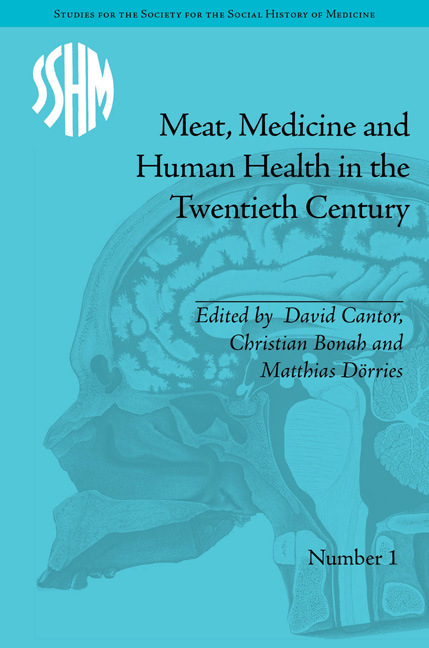Book contents
- Frontmatter
- CONTENTS
- Acknowledgements
- List of Contributors
- List of Figures and Tables
- Introduction
- Part 1 Meat and Therapeutics
- 1 Zomine: A Tale of Raw Meat, Tuberculosis, Industry and War in Early Twentieth Century France
- 2 Treat with Meat: Protein, Palatability and Pernicious Anaemia in the 1920s–30s
- 3 How Abattoir ‘Biotrash’ Connected the Social Worlds of the University Laboratory and the Disassembly Line
- Part II Meat, Politics and Culture
- Part III Meat, Risk and Regulation
- Notes
- Index
2 - Treat with Meat: Protein, Palatability and Pernicious Anaemia in the 1920s–30s
from Part 1 - Meat and Therapeutics
- Frontmatter
- CONTENTS
- Acknowledgements
- List of Contributors
- List of Figures and Tables
- Introduction
- Part 1 Meat and Therapeutics
- 1 Zomine: A Tale of Raw Meat, Tuberculosis, Industry and War in Early Twentieth Century France
- 2 Treat with Meat: Protein, Palatability and Pernicious Anaemia in the 1920s–30s
- 3 How Abattoir ‘Biotrash’ Connected the Social Worlds of the University Laboratory and the Disassembly Line
- Part II Meat, Politics and Culture
- Part III Meat, Risk and Regulation
- Notes
- Index
Summary
In the early 1920s patients diagnosed with pernicious anaemia faced a difficult future. The symptoms of the disease included weakness, pallor and yellowness of the skin and fatigue; patients experienced palpitations of the heart and breathlessness when they attempted physical effort, troubling disturbances of the digestive system, including sore mouth, sore tongue, vomiting and diarrhoea, and numbness of the lower extremities. Even worse, most patients died within one to two years after learning about their disease. As science writer Paul de Kruif memorably remarked ‘in 1925 being told you had pernicious anaemia meant the undertaker for you more surely than if the governor had signed your death warrant for first degree murder’.
By the end of the decade, however, the picture of pernicious anaemia had drastically changed. In 1930 life insurance statisticians reported that mortality from the disease among white persons between the ages of fifty-five and seventy-four had been reduced by 50 per cent. This dramatic change did not result from ‘some extremely complicated deep science out of a white-tile-and-glass-door-knob laboratory and cooked by some abstruse highbrow investigator’. Instead the solution to the problem was feeding patients a food category that most Americans had regarded with scant enthusiasm, the so-called organ meats or ‘edible viscera’ – heart, kidney and especially liver of animals. As physician William Murphy recalled, liver was regarded as ‘cat food’, barely palatable and ‘hardly digestible for a human being, particularly a sick one’.
- Type
- Chapter
- Information
- Meat, Medicine and Human Health in the Twentieth Century , pp. 47 - 62Publisher: Pickering & ChattoFirst published in: 2014



